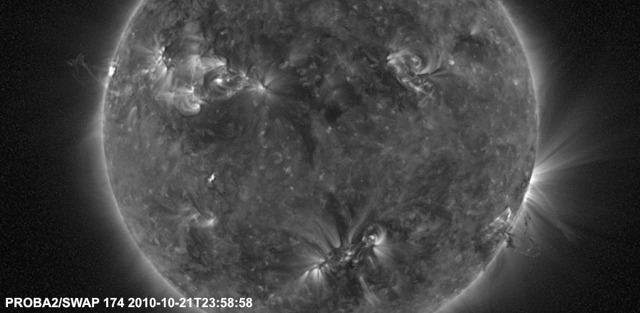| PROBA2, the Belgian space weather satellite, has his first anniversary |
| PROBA2 team members of the Royal Observatory of Belgium look back |
| posted: Oct 29, 2010 |
|
How it started: November 2, 2009, 02:50 LT: the satellite PROBA2 was launched into space on board a Rockot from the cosmodrome in Plesetsk. Just before 06:00LT the first sign of life arrived at the ground station in Redu, Belgium. PROBA2 began its first orbit around the earth. For the Royal Observatory of Belgium, ROB, the space adventure began. The ROB operates two solar instruments onboard PROBA2: SWAP takes pictures of the sun in EUV and LYRA measures the solar radiation in 4 band passes in EUV and X-ray. In first instance, the pointing precision of PROBA2 needed to be fine tuned. The sun was not nicely centered in the SWAP images. The complete PROBA2 team with people from companies as QinetiQ, the Redu-group, the scientists and technicians of the ROB, contributed to solving the problems with controlling the satellite. Anik De Groof, ESA scientist: 'It was really challenging to collaborate with so many teams. Everybody and everything was crucial to get the PROBA2 project going.' Operations The operational team of the ROB commands SWAP and LYRA. The tasks are translated in satellite language and passed through an automatic process to the satellite from the ground station in Redu. PROBA2 is able to interpret a command, it can point itself, perform the measurements and process the data. This onboard autonomy is one of the demonstration goals of this mission. The ROB scientists have almost complete control over the telescope commands. In a way of speaking, they steer SWAP and LYRA with a joy stick. This is unique. The commanding of the telescopes requires a non trivial and secure management in which everything should be checked 4 times. Mistakes have a large impact on the rest of the operations. Bogdan Nicula: 'It is so important that nothing goes wrong, this is stressing but at the same time very challenging.' Another important part of the mission is the data-management. Elke D'Huys: 'We often had to work against time to get all the data processed with aid of specially tailored software. It involves more then only getting a picture down: you have to make sure that all the pieces of the puzzle fit.' Science PROBA2 started a broad international collaboration on the science level. Scientists are invited to do research based on SWAP and LYRA data at the ROB in the frame of the Guest Investigators Program. The first scientific results and articles are being written. SWAP can picture a large field of the solar atmosphere. The field of view can even be broadened thanks to the off-pointing technique: PROBA2 turns as a whole and looks away from the sun into the far corona. This is state-of-the-art technology and science. Dan Seaton, scientist: 'SWAP is a really unique instrument. Not only has it shown us parts of the solar corona that have never been seen before but, because it carries so much new technology, it has also given us a glimpse of the future of solar science.' David Berghmans, head of the PROBA2 Science Centre: 'This wide field of view is never done. With this technique we can figure out how plasma clouds are ejected, accelerated, decelerated and change direction.' SWAP is the third eye of the two twin satellites STEREO A and STEREO B. These satellites lost their stereo view of the sun because they are separated too far from each other. PROBA2 is situated in the middle and gives us the possibility again to make a 3D reconstruction of plasma clouds. Marilena Mierla, scientist: 'Thanks to PROBA2 we can continue with our STEREO project. SWAP has an enormous scientific more value.' Space Weather SWAP en LYRA performed very well already. On October 16, SWAP and LYRA witnessed a strong flash of radiation on the sun: the electromagnetic radiation increased suddenly and very strongly at a certain location on the solar disk. Petra Vanlommel, space forecaster on duty: 'Data of other satellites was not available at that moment. SWAP helped us to subtract information about the location of the flare and about possible other associated space weather events.' Marie Dominique, head of the LYRA team, describes one year of PROBA2: 'PROBA2 is not only useful to improve our understanding of the sun and space weather right now, it is helping us to develop the next generation of tools and observatories that will take our understanding of the sun to the next level.' |
 |
| The EUV corona seen by PROBA2/SWAP on October 21, 2010, zoomed in on the center of the original image. The enlighted structures on the solar disk are active region. They look bright because the plasma at that location is warmer compared to the surrounding plasma. With warm we mean temperatures around 1 miljon degrees Celsius. In the left upper corner and in the right corner below, you see filaments that will erupt later that day. On the right, you see an active region from the side. De lines/fields are the magnetic field that fans out. |
| 2010-10-21: the movie |
| http://proba2.sidc.be |
 |
 |
 |